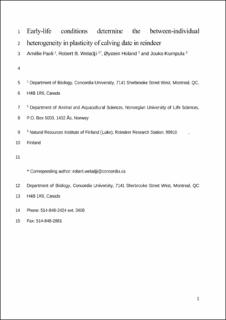| dc.contributor.author | Paoli, Amelie | |
| dc.contributor.author | Weladji, Robert B. | |
| dc.contributor.author | Holand, Øystein | |
| dc.contributor.author | Kumpula, Jouko | |
| dc.date.accessioned | 2020-10-09T12:31:38Z | |
| dc.date.available | 2020-10-09T12:31:38Z | |
| dc.date.created | 2019-11-21T18:34:47Z | |
| dc.date.issued | 2019 | |
| dc.identifier.citation | Journal of Animal Ecology. 2019, 1-14. | en_US |
| dc.identifier.uri | https://hdl.handle.net/11250/2682046 | |
| dc.description.abstract | Phenotypic plasticity has become a key concept to enhance our ability to understand the adaptive potential of species to track the pace of climate change by allowing a relatively rapid adjustment of life‐history traits.
Recently, population‐level trends of an earlier timing of reproduction to climate change have been highlighted in many taxa, but only few studies have explicitly taken into consideration between‐individual heterogeneity in phenotypic plasticity.
Using a long‐term data of a semi‐domesticated reindeer (Rangifer tarandus) population, we demonstrated that females differed greatly in their mean calving date but only slightly in the magnitude of their plastic response to the amount of precipitation in April. We also showed that despite the absence of a population trend, females individually responded to the amount of precipitation in April by delaying their calving dates.
Females' calving date under average climatic conditions was best predicted by their birthdate, by their physical condition in March–April–May before their first calving season and by their first calving date. The degree of their phenotypic plasticity was not dependent on any of the females' attributes early in life tested in this study. However, females who delayed their calving dates in response to a higher amount of precipitation in April slightly produced less calves over their reproductive life.
These findings confirmed that early‐life conditions of female reindeer can shape their phenotypic value during reproductive life, supporting the importance of maternal effects in shaping individuals' lifetime reproductive success. Whether females differed in the magnitude of their plastic response to climatic changes has received contrasted responses for various ungulate species. This calls for more research to enhance our understanding of the underlying mechanisms, leading to the complexity of plastic responses among populations to cope with current climate change. | en_US |
| dc.language.iso | eng | en_US |
| dc.rights | Attribution-NonCommercial-NoDerivatives 4.0 Internasjonal | * |
| dc.rights.uri | http://creativecommons.org/licenses/by-nc-nd/4.0/deed.no | * |
| dc.title | Early-life conditions determine the between-individual heterogeneity in plasticity of calving date in reindeer | en_US |
| dc.type | Peer reviewed | en_US |
| dc.type | Journal article | en_US |
| dc.description.version | acceptedVersion | en_US |
| dc.source.pagenumber | 1-14 | en_US |
| dc.source.journal | Journal of Animal Ecology | en_US |
| dc.identifier.doi | 10.1111/1365-2656.13096 | |
| dc.identifier.cristin | 1750716 | |
| cristin.unitcode | 192,10,1,0 | |
| cristin.unitname | Institutt for husdyr- og akvakulturvitenskap | |
| cristin.ispublished | true | |
| cristin.fulltext | postprint | |
| cristin.qualitycode | 2 | |

